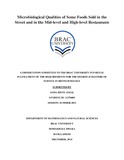| dc.contributor.advisor | Choudhury, Prof. Dr. Naiyyum | |
| dc.contributor.advisor | Hossain, Dr. M. Mahboob | |
| dc.contributor.author | Asma Binte Afzal | |
| dc.date.accessioned | 2014-12-08T07:35:55Z | |
| dc.date.available | 2014-12-08T07:35:55Z | |
| dc.date.copyright | 2014 | |
| dc.date.issued | 2014-12 | |
| dc.identifier.other | ID 11376003 | |
| dc.identifier.uri | http://hdl.handle.net/10361/3846 | |
| dc.description | This thesis report is submitted in partial fulfillment of the requirement for the degree of Masters of Science in Biotechnology, 2014. | en_US |
| dc.description | Cataloged from PDF version of thesis report. | |
| dc.description | Includes bibliographical references (page 95 - 103). | |
| dc.description.abstract | Street foods and restaurant foods play an important role in people’s daily food options as well as their regular nutritional requirements are dependent on these foods, as their ever-growing busy schedule take away the opportunity to eat homemade food. Due to expedient availability, these street and restaurant foods are one of the primary food options for city people. Over the years, many food-borne diseases have been reported due to contaminated non-homemade food consumption. This study was conducted to analyze the microbiological quality of foods which are sold in street side, mid-level restaurants and high-level restaurants. This research study observed , and analyzed the microbiological quality of seven most commonly consumed food items of street side carts, mid-level restaurants and high-level restaurants of Paribagh and Kawran Bazaar areas of Dhaka city, Bangladesh. Total viable count (TVC), Coliform and Enteric pathogen count (CEC), Staphylococci count (SC), Fungal count (FC) and also the presence of urinary tract infection causing pathogens, Salmonella spp., Shigella spp. were observed in this study. It has been found out that, cooked food items showed less microbial load than raw food. Mid-level restaurant foods showed less microbial load than street side cart and high-level restaurant foods. According to the biochemical test results 27% invasive pathogens, 61% opportunistic pathogens and 12% rare pathogens were found in food samples. Invasive food pathogens were Staphylococcus aureus (54.54%), Bacillus cereus (27.27%), Shigella dysentriae (9.09%), Proteus mirabilis (9.09%) and also positively identified some opportunistic and rare pathogens from obtained food samples. This study specifically highlights the level of microbial loads found in various available non-homemade foods. Finally, this study recommends some preventive measures which the government and food-maker together should follow, and also maintain the standard hygienic procedure to prepare, cook and handle foods. Implementation of such measures, rules and regulations on street food vendors and restaurant foods are extremely crucial to maintain the hygienic condition as well as to avoid such spreading of harmful organisms through consumption of contaminated foods. | en_US |
| dc.description.statementofresponsibility | Asma Binte Afzal | |
| dc.format.extent | 113 pages | |
| dc.language.iso | en | en_US |
| dc.publisher | BRAC University | en_US |
| dc.rights | BRAC University thesis are protected by copyright. They may be viewed from this source for any purpose, but reproduction or distribution in any format is prohibited without written permission. | |
| dc.subject | Biotechnology | en_US |
| dc.subject | Biotechnology | |
| dc.subject | Street foods | |
| dc.title | Microbiological qualities of some foods sold in the street and in the mid-level and high-level restaurants | en_US |
| dc.type | Thesis | en_US |
| dc.contributor.department | Department of Mathematical and Natural Science, BRAC University | |
| dc.description.degree | M. Biotechnology | |

